44 results
8th grade other (math) scaffolded notes for Easel
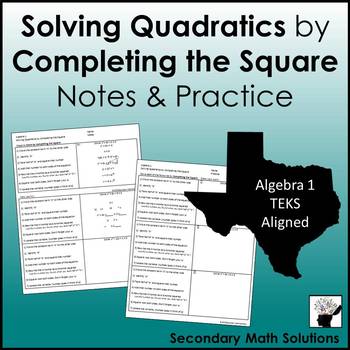
Solving Quadratics by Completing the Square Notes & Practice
This is a double-sided page with notes on one side and practice on the other covering Solving Quadratics by Completing the Square.This resource is intended for the beginning Algebra 1 student. On the front, 3 examples are given with steps and the first example is completely worked out. The second example helps the student along with some blanks to be filled in. The back provides 3 more examples that can be used as guided practice. All 6 examples include the same steps listed for the student and
Subjects:
Grades:
8th - 11th
Also included in: Solving Quadratic Equations Unit Bundle - Algebra 1 Curriculum
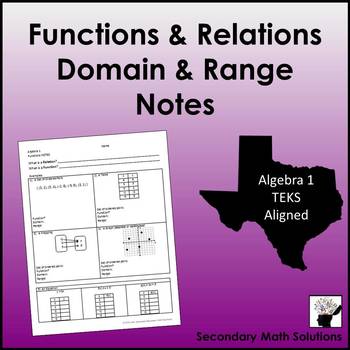
Functions & Relations, Domain & Range Notes
This is a one-sided fill-in-the-blank notes page on differentiating between a function and a relation, exploring the 5 types of functions/relations, and then finding the domain and range of each. The student first takes notes on the definition of a relation and a function. Then looks at examples of the 5 types: a set of ordered pairsa table of valuesa mappinga discrete graphan equation. Then the student identifies the domain and range of each example. Key included. Related resources that you mig
Subjects:
Grades:
8th - 11th
Also included in: Functions Unit Bundle - Algebra 1 Curriculum
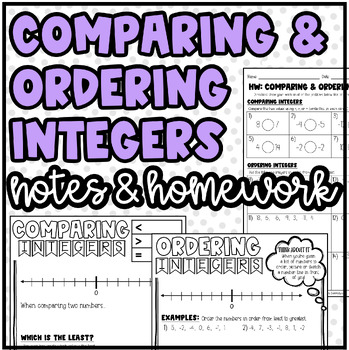
Comparing & Ordering Integers | Notes & Homework or Practice
Comparing & Ordering Integers | Notes to Color and Homework:I recently started doing "notes to color" with my sixth grade kiddos! As they come into class, I give them their notes sheet for the day. They get about 5-7 minutes to get their materials and then calm down by coloring their notes (even if it's something small like coloring or decorating the title)! They have absolutely LOVED IT. They enjoy being able to add a little "pop" to their notes! I've started to create all of my notes like
Subjects:
Grades:
6th - 8th
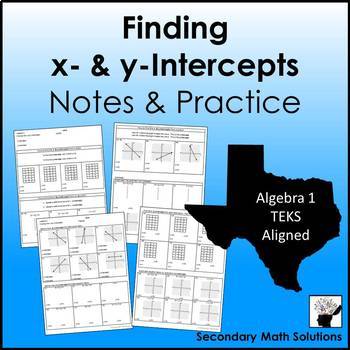
Finding Intercepts Notes & Practice
This is a collection of two double-sided pages over finding x- and y-intercepts.The first double-sided page contains guided notes that can be used to cover all of the situations where a student could be asked to identify the intercepts: from a tablefrom a graphfrom an equation. Finally, the student is asked to use the intercepts to graph an equation given in standard form.The second page provides guided practice over the same concepts. While students are finding the intercepts from a table, they
Subjects:
Grades:
8th - 11th

Adding, Subtracting, Multiplying & Dividing Radicals Notes
This is a double-sided notes page over working with radicals. The notes teach the student how to add, subtract, multiply and divide (including rationalizing the denominator) radicals. Each section tells the student how to complete the operation and then provides two worked out examples with explanations. Each section then provides the student with two examples that they can try. Key included.Complete this concept with my:Adding, Subtracting, Multiplying & Dividing Radicals PracticeRadicals F
Subjects:
Grades:
8th - 11th
Types:
Also included in: Algebra 1 Guided Notes Bundle Texas TEKS Aligned

Standard Form to Slope-Intercept Form Notes & Practice
This is a double sided document with notes on one side and homework on the other over Translating from Standard Form to Slope-Intercept form.The notes side teaches the student how to transfer from standard form to slope-intercept form of a linear equation. There are a total of 6 examples. The back gives the student 12 problems to do for independent practice. The ability to clear fractions is included. Key included. Related resources you might also be interested in:Standard Form to Slope-Intercep
Subjects:
Grades:
8th - 10th
Also included in: Linear Functions Unit Bundle - Algebra 1 Curriculum

Linear Transformations Notes & Practice
Linear Transformations, TEKS Aligned: A3EThe front of the double-sided notes page is a one-page discovery notes page on transforming the linear parent function. The student uses their graphing calculator to discover what changing m and b does to the parent graph. Then they are given equations and asked to predict what the changes will be and check their predictions on the calculator. Finally, they are asked to write the equation of a line that would create the changes indicated. The back is a s
Subjects:
Grades:
8th - 11th
Also included in: Linear Transformations Mini-Bundle

Domain and Range (of Continuous Graphs) Notes
This is a one-sided notes page on finding the Domain and Range of Continuous Graphs. First, the student defines domain and range. Then 9 examples follow that the teacher can use to teach the concept. Key included.Related resources you might also be interested in:Functions & Relations, Domain & Range NotesFunctions or Not, Domain & Range Activity CardsFunctions, Domain & Range FoldableFunctions, Independent/Dependent Variables, Domain/Range ProjectDomain & Range in Real-World
Subjects:
Grades:
8th - 11th
Also included in: Functions Unit Bundle - Algebra 1 Curriculum
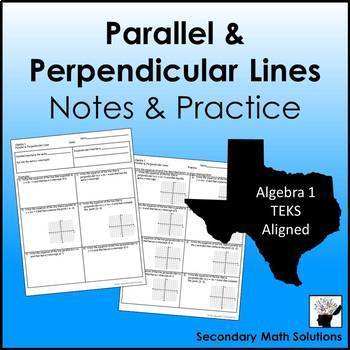
Parallel and Perpendicular Lines Notes & Practice
The first page provides the teacher with a notes page for students over Writing Equations of Parallel & Perpendicular Lines. First, the student fills in the blank on how slope and y-intercept correspond to parallel and perpendicular lines. Then 6 examples follow. The two special cases (horizontal and vertical lines) are included. Blank graphs are included on 2 examples so that students have options on how to approach the problem. The second page provides 8 more questions that can be used as
Subjects:
Grades:
8th - 11th
Also included in: Writing Equations of Lines Mini-Bundle
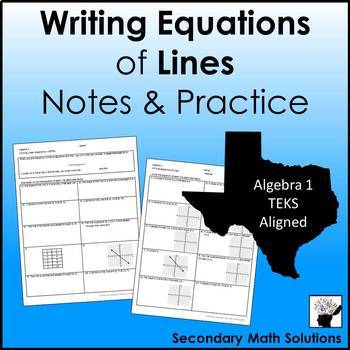
Writing Equations of Lines Notes & Practice (y = mx + b only)
The notes page is a one-sided document with 10 examples where the student needs to write the equation of the line based on a variety of given information in y = mx + b form. Some of the questions include giving the student the graph of the line, a table of values, two points on the line, etc. The practice page provides 10 more questions that can be used for independent practice or assigned for homework. Both pages can be run off front to back for a one-day lesson plan over writing equations in s
Subjects:
Grades:
8th - 11th
Also included in: Writing Equations of Lines Mini-Bundle

Writing Equations of Lines Notes & Practice #2
3 pages over Writing Equations of Lines in Slope-Intercept form and Point-Slope form.The first page is a one-sided notes page that teaches students how to write the equation of a line in either slope-intercept form or point-slope form. 8 examples follow where they have to decide which information they are given and then write the equation of the line accordingly.The next page provides practice over the concept with 14 questions.Also included is a 3rd page specifically offering varied practice ov
Subjects:
Grades:
8th - 11th
Also included in: Writing Equations of Lines Mini-Bundle

Solving Inequalities Notes & Practice
The first page is a one-sided notes page on Solving one-step, two-step & multi-step Inequalities in one variable. A total of 14 examples are included and start off easy with one-step inequalities and move on to two-step, variables on both sides and distributive property examples. The point is not so much to teach the student how to solve (since they should already know how to do this), but to reinforce the concept of having to flip the sign or not. The examples can be used for in-class guide
Subjects:
Grades:
6th - 8th

Why Do We Need to Flip the Inequality Sign? Discovery Activity
This one-page discovery activity leads the student through trial and error to discover what happens when an operation is applied to a true inequality statement. 6 examples are given - two will lead to a false statement (multiplying and dividing both sides by a negative). The student answers some questions afterwards and has to sum up what they discovered. Hopefully, this will help the student remember in the future to flip the inequality sign at the appropriate times when solving. Key included.
Subjects:
Grades:
7th - 11th
Also included in: Linear Inequalities Unit Bundle - Algebra 1 Curriculum
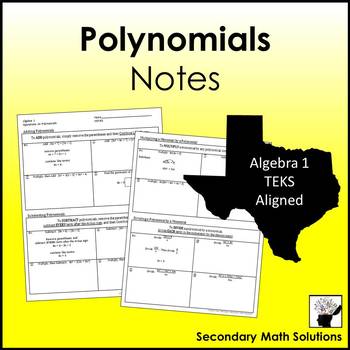
Adding, Subtracting, Multiplying & Dividing Polynomials Notes
This is a double-sided notes page on adding, subtracting, multiplying (a monomial by a polynomial) and dividing (a polynomial by a monomial) polynomials. The student is given instructions on each case and one example that is worked out. Then each situation includes 3 more examples that the teacher can use as explanation or guided practice. Key included. Also available:Adding & Subtracting Polynomials Cut & Paste ActivityMultiplying Binomials ActivityDividing Polynomials by a Monomial Col
Subjects:
Grades:
8th - 11th
Also included in: Polynomials Unit Bundle - Algebra 1 Curriculum
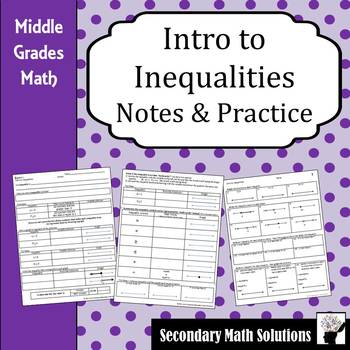
Inequalities Notes & Practice
The first page is a double-sided fill-in-the blank notes page with examples over the introductory concepts of Inequalities. The notes begin by having the student write the definition of an inequality and then record the inequality symbols. The focus of the notes is to understand what the inequality is asking for and not to just use a memorization trick. The student is asked to find solutions to each inequality by finding numbers that make the inequality true. Then they graph the solutions on the
Subjects:
Grades:
6th - 9th

Intro to Quadratic Functions Notes
This is a double-sided notes page to teach Algebra students the basic concepts of a quadratic function. The notes start with graphing the parent function by making a t-table, then the notes ask the student many questions about their graph such as is your graph linear?does it have a maximum or minimum point?does the graph cross the x- or y-axis?, etc. Next the 4 key vocabulary words are defined: quadratic function, vertex, roots/zeros and axis of symmetry. The students can then go back and label
Subjects:
Grades:
8th - 11th
Also included in: Quadratic Functions Unit Bundle - Algebra 1 Curriculum

Finding Slope Notes
This is a double-sided notes page on how to find the Slope given 5 different situations:from 2 points from a table of valuesfrom a graph from a verbal description from an equation. Key included.Pair this resource with my Slope Practice for a comprehensive one-day lesson plan!© 2014 Secondary Math Solutions Products created by Secondary Math Solutions and purchased through Teachers Pay Teachers are for classroom use only. All rights reserved. No part of th
Subjects:
Grades:
8th - 11th
Also included in: Slope Bundle

Ontario Math Curriculum │ Financial Literacy │ Credit Cards │ PPT │ Grades 7-9
This comprehensive Ontario financial literacy lesson covers various topics related to credit cards and loan sharks, annual percentage rates, creditworthiness, debt and interest rates, principal and interest payments, credit limits, and hidden fees. The lesson provides opportunities for students to research, write, reflect, and express their opinions on these important financial matters.Understanding Credit Cards: Pros and ConsOverview of Credit Card Benefits and Drawbacks: Students will gain ins
Subjects:
Grades:
7th - 9th
Types:
Also included in: Comprehensive Middle School Financial Literacy Bundle | Grades 7-9

Simplifying Radicals Notes
This is a double-sided notes page over simplifying square roots.The front side begins by having the student label a schematic containing a radical. Next, the student is asked to list the perfect squares. Then, the student is given specific steps as to how to simplify a square root by using perfect squares. The first example is fully worked out for the student, whereas the second example gives them blanks to fill in. Six more questions follow after this that can be used as guided practice. Need h
Subjects:
Grades:
8th - 11th
Types:
Also included in: Radicals & Rational Exponents Mini-Bundle - Algebra 1 Curriculum
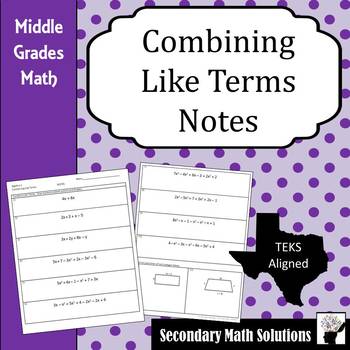
Combining Like Terms Notes
This is a double-sided notes page used to teach combining like terms. There are 10 examples that increase in difficulty as you progress down the page and can be used as notes examples and guided practice. I teach this concept with colored pencils/markers and shapes so the font is large. On the last two examples, the student is asked to find the perimeter of a polygon using the concept. 4 pages. Key included.Looking for coloring notes on the same topic? Check out my Combining Like Terms Coloring
Subjects:
Grades:
6th - 9th
Types:

Quadratic Formula Notes
This is a double-sided notes page used to teach the Quadratic Formula.The notes give 6 steps to use to solve a quadratic equation by using the quadratic formula including identifying a, b & c, finding 4ac, -b, b squared and 2a first. (See preview). These steps are on all 4 examples.The first example is completely worked out for the student, the second example (preview) gives blanks in the process for the student to fill in. The two examples on the back are used as in class guided practice an
Subjects:
Grades:
8th - 11th
Types:
Also included in: Solving Quadratic Equations Unit Bundle - Algebra 1 Curriculum

Functions & Relations, Domain & Range Practice
This is a one-sided practice page with 9 questions over identifying functions from relations and then finding the domain and range of each. This practice page includes mappings, tables, discrete graphs and equations. There are no continuous graphs. Key included. Related resources you might also be interested in:Functions or Not, Domain & Range Activity CardsFinding Function Values ActivityFunctions Review ActivityFunctions, Independent/Dependent Variables, Domain/Range ProjectDomain & R
Subjects:
Grades:
8th - 11th
Also included in: Functions Unit Bundle - Algebra 1 Curriculum

Systems of Equations: Types of Solutions
Systems Solutions - Notes & Practice This is a double-sided worksheet with notes on one side and homework problems on the other over the types of solutions to Systems of Equations. The worksheet covers solving a system of linear equations either by graphing or substitution and then teaches the student about the 3 types of solutions you could end up with: one solution, infinitely many solutions or no solutions. On the notes side, the student writes down what it means to solve a system of equa
Subjects:
Grades:
8th - 11th
Also included in: Systems of Equations Unit Bundle - Algebra 1 Curriculum

Factoring Trinomials Notes (a = 1)
This is a double-sided notes page used to teach a beginner how to factor a trinomial where a = 1. TEKS Aligned: A10EThe notes begin by asking the student to write down what it means to factor. Then, the student is asked to review how to multiply two binomials. The notes explain where b and c of the trinomial x^2 + bx + c come from and then steps are provided to have the student use b and c to help them find the factors of the trinomial. The student writes down all factors of c (including negati
Subjects:
Grades:
8th - 11th
Also included in: Factoring Unit Bundle - Algebra 1 Curriculum
Showing 1-24 of 44 results









